- The paper establishes significant differences in core hydrogen mixing and magnetic field topology between collisions and mergers using AREPO MHD simulations.
- It demonstrates that merger products achieve higher core rejuvenation, rapid differential rotation, and ordered magnetic fields leading to bipolar outflows.
- The study implies that stellar interaction dynamics crucially impact long-term evolution and magnetic phenomena in massive stars.
Magnetohydrodynamic Distinctions Between Stellar Collision and Merger Products
Introduction
This paper presents a systematic magnetohydrodynamic (MHD) comparison of the outcomes of stellar collisions and mergers among main-sequence (MS) stars in the $5$–10M⊙ range. Using the AREPO moving-mesh MHD code, the authors simulate both parabolic collisions and binary mergers, focusing on the resulting internal structure, chemical mixing, rotation, magnetic field amplification, and outflow properties. The central claim is that, despite superficial similarities, the products of collisions and mergers exhibit quantitatively and qualitatively distinct properties, particularly in their magnetic field configurations and outflow phenomena.
Simulation Methodology and Initial Conditions
The initial stellar models are generated with MESA for $10$ Myr-old, non-rotating MS stars at solar metallicity. These 1D profiles are mapped to 3D AREPO meshes using HEALPix shell-layering, followed by relaxation to ensure dynamical stability. The initial magnetic field is a dipole configuration with Bpole=1 G, truncated at $100$ G in the core to avoid numerical artifacts. The simulations resolve each star with ∼2×105 cells per M⊙, yielding numerical Reynolds numbers Renum∼700–$1000$, sufficient for capturing turbulent magnetic amplification.
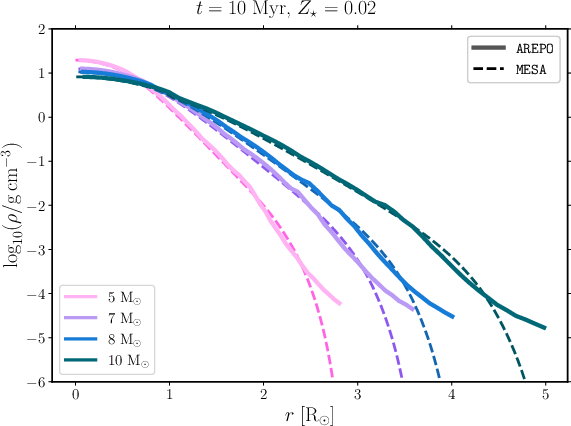
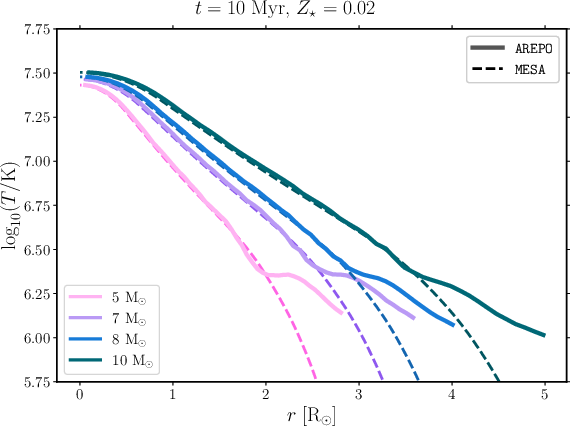
Figure 1: Initial density and temperature profiles of $10$ Myr-old MS stars of different masses, showing agreement between MESA and AREPO except at low-density outer layers.
Collisions are modeled as parabolic encounters with impact parameters b=0.25 and b=0.50 (where b is the closest approach in units of the sum of stellar radii). Mergers are initiated from circular binaries with artificially accelerated inspiral to achieve coalescence on computationally feasible timescales.
Chemical Mixing and Core Rejuvenation
Both collisions and mergers induce strong mixing, transporting hydrogen from the envelope into the core and helium outward, resulting in rejuvenated cores. However, merger products consistently exhibit higher core hydrogen fractions—up to 10% greater than collision products in some cases. This difference is attributed to the sorting of material by buoyancy during coalescence, with merger dynamics favoring the less massive star's material in the core.
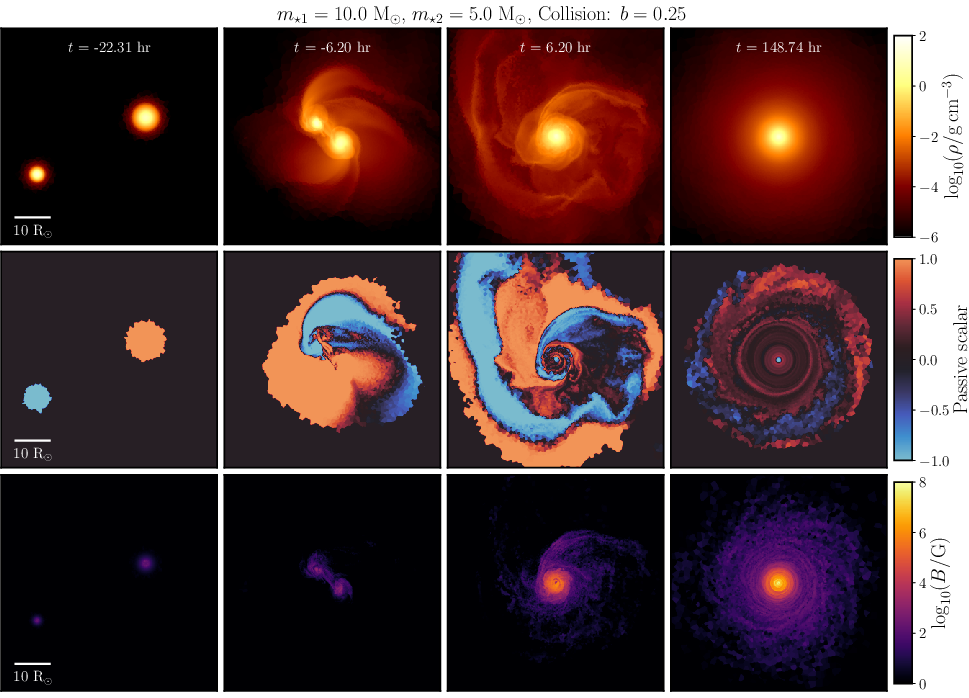
Figure 2: Mid-plane snapshots of a 10M⊙ + 5M⊙ collision (b=0.25), showing density, passive scalar mixing, and magnetic field amplification at four stages.
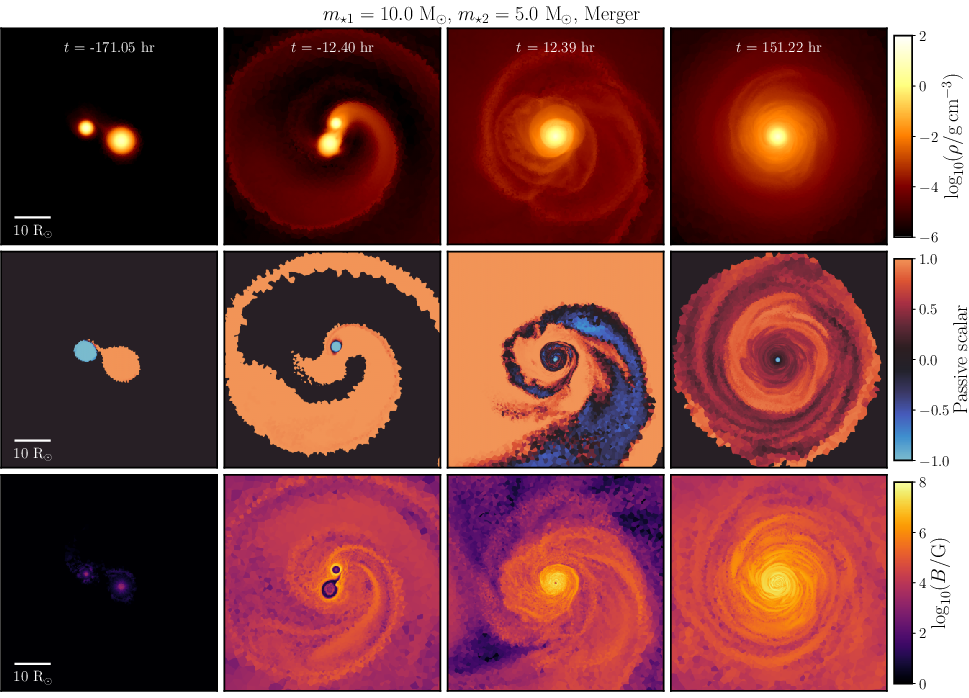
Figure 3: Analogous mid-plane snapshots for a 10M⊙ + 5M⊙ merger, highlighting more pronounced magnetic field amplification and distinct mixing patterns.

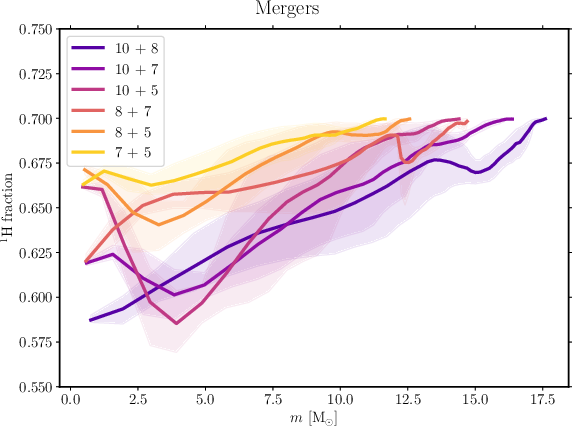
Figure 4: Mass profiles of hydrogen fraction X for collision (left) and merger (right) products, demonstrating higher core X in mergers.
The enhanced core hydrogen in mergers implies longer MS lifetimes and potentially divergent post-MS evolutionary tracks, especially in the context of blue straggler formation and supergiant progenitors.
Rotational Properties and Structural Flattening
Angular momentum transfer during coalescence leads to rapid, differential rotation in both collision and merger products. Merger products and b=0.50 collision products reach angular frequencies ω/ωcrit∼0.8–$0.9$, while b=0.25 collision products are limited to ∼0.5–$0.6$. The degree of rotational flattening correlates with spin rate: merger products exhibit peanut-shaped density contours, in contrast to the ellipsoidal shapes of collision products.


Figure 5: Radial profiles of ω/ωcrit for collision (left) and merger (right) products, showing mergers closer to break-up velocity.
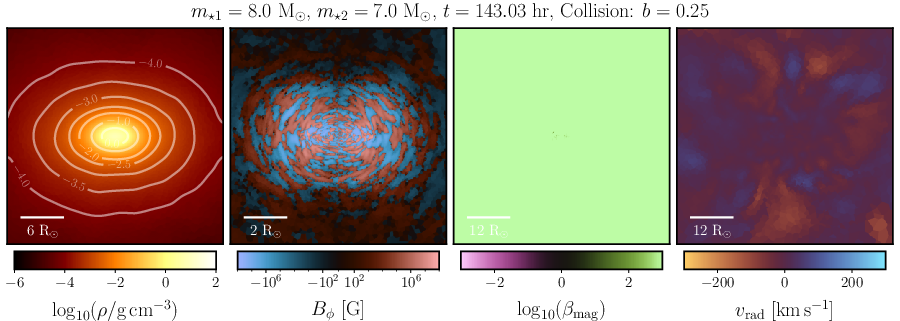
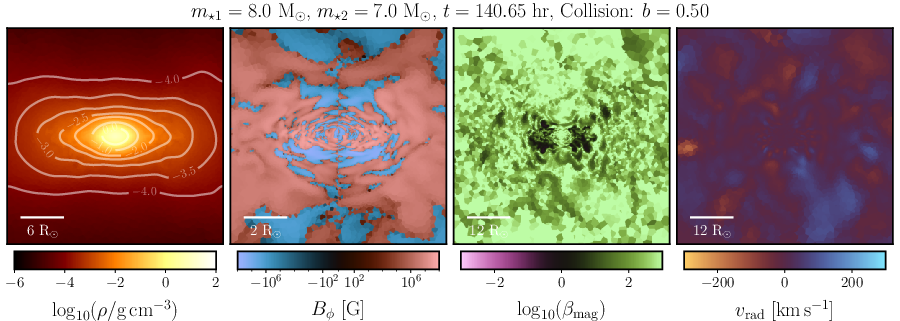
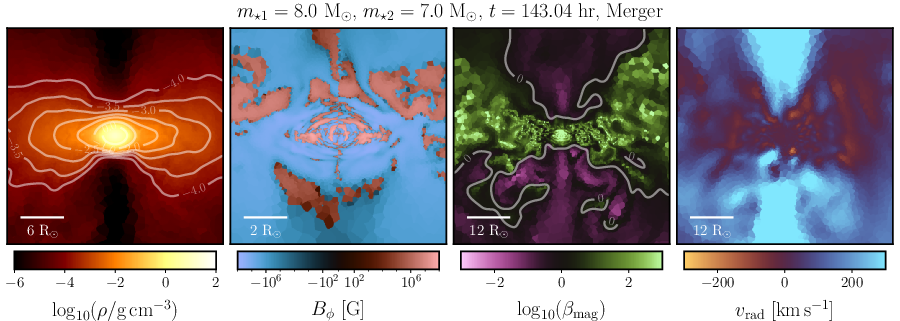
Figure 6: Edge-on slices of density, azimuthal magnetic field, plasma beta, and radial velocity for 8+7M⊙ collision (b=0.25 and b=0.50) and merger products, illustrating structural and magnetic differences.
Magnetic Field Amplification and Topology
Turbulent mixing during coalescence drives exponential amplification of magnetic energy by $9$–$12$ orders of magnitude, saturating at Emag∼1045–1048 erg. Merger products and b=0.50 collision products reach higher Emag than b=0.25 collisions. Crucially, the magnetic field topology differs: b=0.25 collision products exhibit small-scale reversals, indicative of short-lived fields susceptible to reconnection and dissipation. In contrast, merger products and b=0.50 collisions develop large-scale, ordered fields conducive to long-term dynamo action.


Figure 7: Time evolution of total magnetic energy for collisions (left) and mergers (right), showing rapid amplification and higher saturation in mergers.
The presence of large-scale ordered fields in merger products aligns with observational evidence for strong magnetism in a subset of massive stars and supports merger-driven magnetar formation scenarios.
Magnetized Bipolar Outflows
A key distinction is the emergence of magnetically driven, bipolar axial outflows in merger products, with radial velocities vr>300–$400$ km/s and plasma beta β∼0.01–$0.1$ (magnetic pressure dominating). These outflows are absent in all collision products, regardless of impact parameter. The development of outflows is attributed to the longer interaction timescales and sustained central magnetic fields in mergers, which allow for collimation and acceleration of low-density material along the rotation axis.
(Figure 6, rightmost column)
Figure 6: Bipolar axial outflows in the merger product, absent in collision products, as revealed by edge-on radial velocity slices.
This result has implications for the formation of magnetized winds, circumstellar nebulae, and the observational signatures of merger remnants.
Implications and Future Directions
The paper demonstrates that the products of stellar collisions and mergers, while both more massive, magnetized, and rapidly rotating, are fundamentally distinct in their internal structure, magnetic field topology, and outflow properties. The enhanced core hydrogen and large-scale magnetic fields in merger products suggest longer lifetimes and greater potential for sustained magnetism, with direct relevance to the origin of blue stragglers, magnetic massive stars, and magnetars.
The absence of magnetized outflows in collision products, even at higher impact parameters, underscores the importance of interaction timescale and dynamical history in shaping remnant properties. These findings motivate further investigation using 1D stellar evolution models to track the long-term fate of collision and merger products, as well as observational campaigns to distinguish their signatures in young clusters and the field.
Conclusion
This work provides a comprehensive MHD comparison of stellar collision and merger products, establishing that mergers yield remnants with higher core hydrogen, faster rotation, large-scale ordered magnetic fields, and magnetized bipolar outflows, in contrast to the more chaotic and less magnetized outcomes of collisions. These differences have significant implications for stellar evolution, cluster dynamics, and the origin of magnetic phenomena in massive stars. Future studies should extend these simulations to longer timescales and broader parameter spaces, integrating observational constraints to refine models of stellar interaction outcomes.












